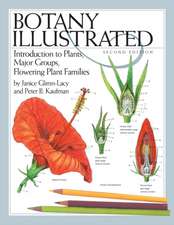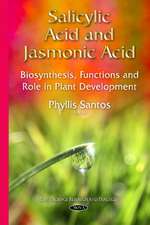Macroclimate and Plant Forms: An Introduction to Predictive Modeling in Phytogeography: Tasks for Vegetation Science, cartea 1
Autor Elgene E. O. Boxen Limba Engleză Paperback – 14 oct 2011
| Toate formatele și edițiile | Preț | Express |
|---|---|---|
| Paperback (1) | 1219.16 lei 43-57 zile | |
| SPRINGER NETHERLANDS – 14 oct 2011 | 1219.16 lei 43-57 zile | |
| Hardback (1) | 1226.60 lei 43-57 zile | |
| SPRINGER NETHERLANDS – 30 sep 1981 | 1226.60 lei 43-57 zile |
Din seria Tasks for Vegetation Science
-
 Preț: 34.59 lei
Preț: 34.59 lei - 20%
 Preț: 554.66 lei
Preț: 554.66 lei -
 Preț: 394.12 lei
Preț: 394.12 lei -
 Preț: 396.02 lei
Preț: 396.02 lei -
 Preț: 402.76 lei
Preț: 402.76 lei - 24%
 Preț: 790.13 lei
Preț: 790.13 lei - 18%
 Preț: 1825.75 lei
Preț: 1825.75 lei - 18%
 Preț: 1218.69 lei
Preț: 1218.69 lei - 24%
 Preț: 784.53 lei
Preț: 784.53 lei - 18%
 Preț: 1233.69 lei
Preț: 1233.69 lei -
 Preț: 73.90 lei
Preț: 73.90 lei - 18%
 Preț: 1222.01 lei
Preț: 1222.01 lei - 18%
 Preț: 952.09 lei
Preț: 952.09 lei - 18%
 Preț: 1225.94 lei
Preț: 1225.94 lei -
 Preț: 388.31 lei
Preț: 388.31 lei -
 Preț: 391.40 lei
Preț: 391.40 lei - 18%
 Preț: 1220.45 lei
Preț: 1220.45 lei - 18%
 Preț: 949.23 lei
Preț: 949.23 lei - 18%
 Preț: 943.73 lei
Preț: 943.73 lei - 18%
 Preț: 1238.11 lei
Preț: 1238.11 lei - 18%
 Preț: 1232.26 lei
Preț: 1232.26 lei - 24%
 Preț: 796.72 lei
Preț: 796.72 lei - 24%
 Preț: 1068.94 lei
Preț: 1068.94 lei -
 Preț: 368.39 lei
Preț: 368.39 lei - 18%
 Preț: 1230.03 lei
Preț: 1230.03 lei - 24%
 Preț: 783.41 lei
Preț: 783.41 lei - 18%
 Preț: 948.16 lei
Preț: 948.16 lei - 18%
 Preț: 948.61 lei
Preț: 948.61 lei - 24%
 Preț: 1053.39 lei
Preț: 1053.39 lei
Preț: 1219.16 lei
Preț vechi: 1486.77 lei
-18% Nou
Puncte Express: 1829
Preț estimativ în valută:
233.28€ • 244.22$ • 193.03£
233.28€ • 244.22$ • 193.03£
Carte tipărită la comandă
Livrare economică 07-21 aprilie
Preluare comenzi: 021 569.72.76
Specificații
ISBN-13: 9789400986824
ISBN-10: 9400986823
Pagini: 276
Ilustrații: XIII, 258 p.
Dimensiuni: 178 x 254 x 14 mm
Greutate: 0.49 kg
Ediția:Softcover reprint of the original 1st ed. 1981
Editura: SPRINGER NETHERLANDS
Colecția Springer
Seria Tasks for Vegetation Science
Locul publicării:Dordrecht, Netherlands
ISBN-10: 9400986823
Pagini: 276
Ilustrații: XIII, 258 p.
Dimensiuni: 178 x 254 x 14 mm
Greutate: 0.49 kg
Ediția:Softcover reprint of the original 1st ed. 1981
Editura: SPRINGER NETHERLANDS
Colecția Springer
Seria Tasks for Vegetation Science
Locul publicării:Dordrecht, Netherlands
Public țintă
ResearchCuprins
1. Introduction.- 2. Modeling ecological structure and function.- A. World vegetation models in general.- B. The current model.- C. Model structure and technical considerations.- 3. Ecological classification of world vegetation.- A. Vegetation description and vegetation data.- B. Ecophysiognomic characters of terrestrial vegetation.- C. Life forms of world terrestrial vegetation.- 4. Modeling the effective environment.- A. Climate data.- B. Selection of ecoclimatic variables.- C. The ecoclimatic variables and their significance.- 5. The ecological model: life-form limitation, cover and dominance.- A. Ecological data.- B. The environmental-limitation model.- C. The cover model.- D. The dominance model.- E. Proximity to environmental limits.- F. Interpreting vegetation formations.- 6. Model results.- A. Model output and applicability.- B. Generating and mapping world results.- C. Overview of world ecoclimates.- D. Life-form prediction frequency.- E. Predicted plant-form distributions.- F. Predicting world vegetation types.- G. Physiognomic diversity of vegetation.- H. General observations and problems.- 7. Evaluation of model results.- A. Site comparison of predicted and actual vegetation.- B. Vegetation and climate at unusual sites.- C. Vegetation sensitivity to climatic variation.- 8. Conclusions and next steps.- Appendices.- Appendix A. Description of the plant types.- Appendix B. Predicted vegetation at selected representative and well-known sites.- Appendix C. Predicted vegetation at the validation sites.- Appendix D. Actual vegetation at the validation sites.- Appendix E. The macroclimatic data-base.- Appendix F. The processing and mapping programs.- References.











